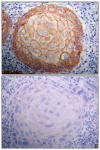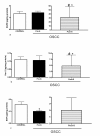Clinical significance of EGFR, Her-2 and EGF in oral squamous cell carcinoma: a case control study
- PMID: 20429940
- PMCID: PMC2877010
- DOI: 10.1186/1756-9966-29-40
Clinical significance of EGFR, Her-2 and EGF in oral squamous cell carcinoma: a case control study
Abstract
Background: The erbB receptors and their ligands are involved in the pathogenesis and progression of oral squamous cell carcinoma (OSCC). Although EGFR and Her-2 are frequently overexpressed in OSCC, few studies evaluated these proteins in saliva and their association with the tumor, which may represent potential usefulness in a clinical setting.
Methods: The levels of EGFR, Her-2, and EGF were evaluated in saliva of 46 patients with OSCC before and after the surgical removal of the lesion, as well as in matched healthy controls. The relationship of salivary levels and EGFR and Her-2 immunoexpression in tumor samples with clinicopathological features was analyzed.
Results: EGFR and Her-2 salivary levels did not show difference between to pre-surgery and control groups, however, both demonstrated an increase after surgical removal of the tumor. No association was detectable among receptor salivary levels, tissue expression and clinicopathological features. EGF levels in pre-surgery group were significantly lower when compared to the control group.
Conclusions: EGFR and Her-2 were not considered to be valuable salivary tumor markers in OSCC, however, lower levels of EGF in saliva may suggest a higher susceptibility for OSCC development.
Figures


References
-
- Erman M. Molecular mechanisms of signal transduction: epidermal growth factor receptor family, vascular endothelial growth factor family, Kit, platelet-derived growth factor receptor, Ras. J BUON. 2007;12(Suppl 1):S83–94. - PubMed
-
- Laimer K, Spizzo G, Gastl G, Obrist P, Brunhuber T, Fong D, Barbieri V, Jank S, Doppler W, Rasse M, Norer B. High EGFR expression predicts poor prognosis in patients with squamous cell carcinoma of the oral cavity and oropharynx: a TMA-based immunohistochemical analysis. Oral Oncol. 2007;43:193–198. doi: 10.1016/j.oraloncology.2006.02.009. - DOI - PubMed
Publication types
MeSH terms
Substances
LinkOut - more resources
Full Text Sources
Medical
Research Materials
Miscellaneous

